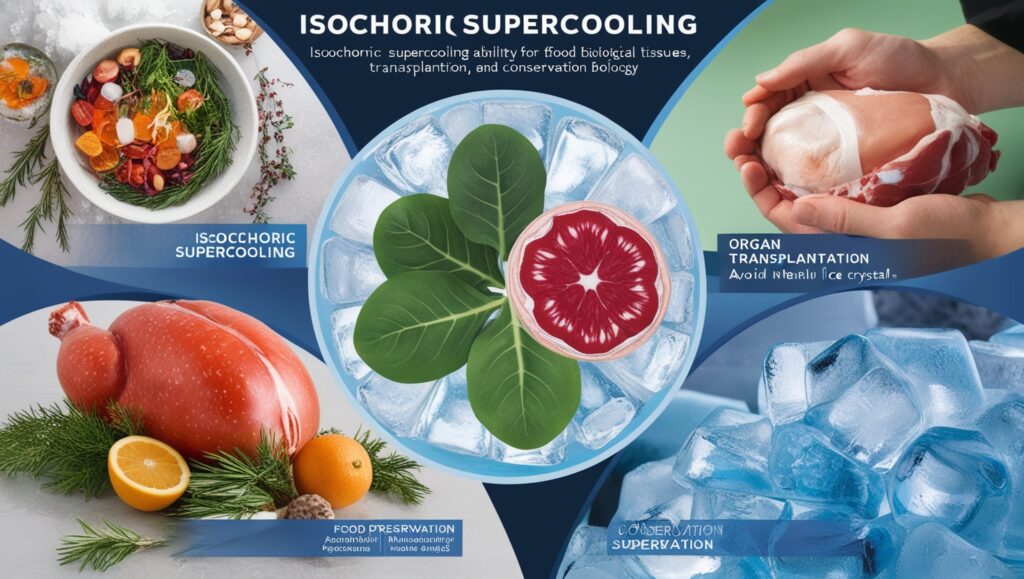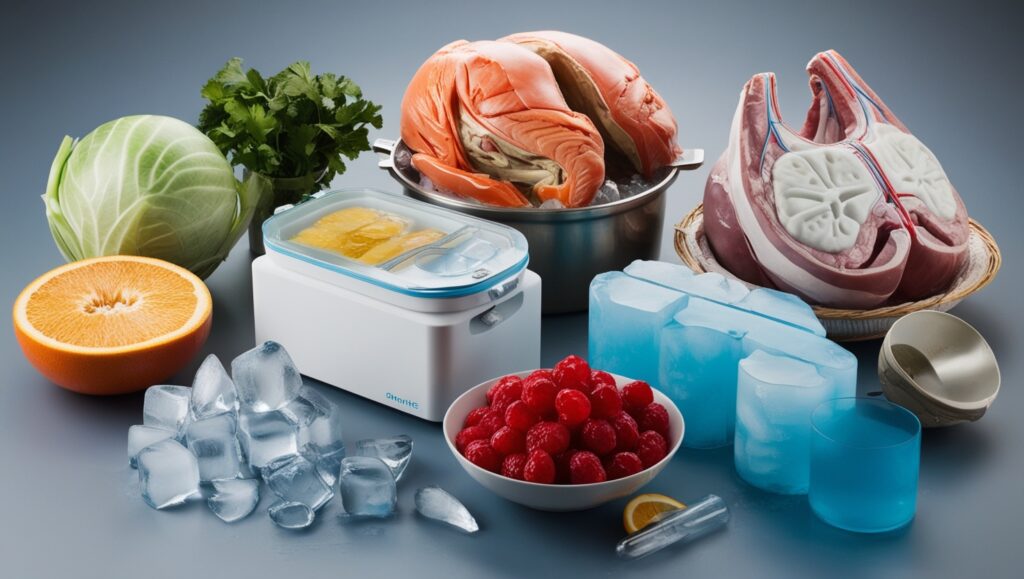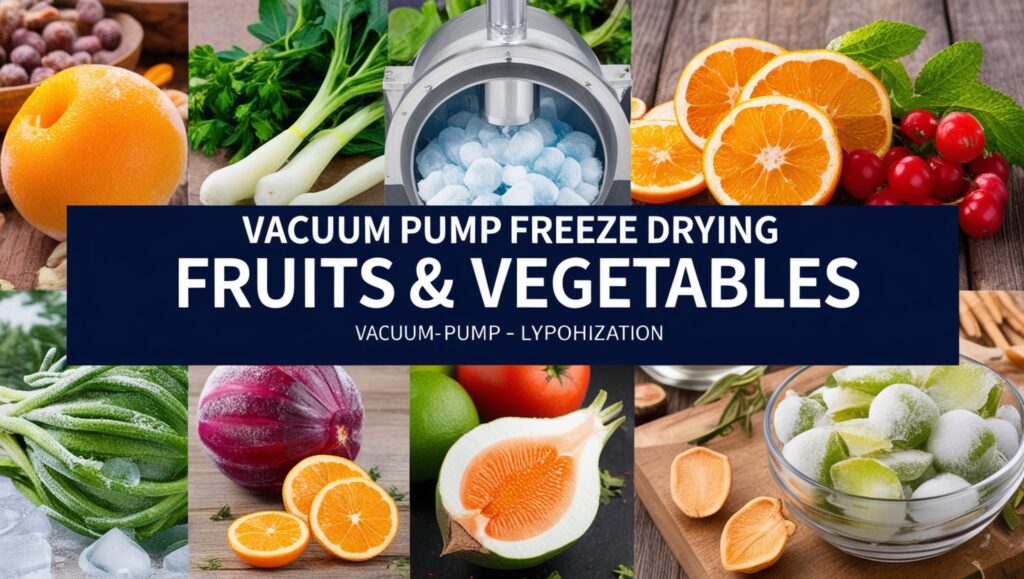
Introduction
Isochoric supercooling is a thermodynamic phenomenon that allows a liquid to be cooled below its freezing point without ice crystal formation, achieved by maintaining a constant volume during the process. This innovative method has gained recognition for its significant applications in diverse fields such as food preservation, organ transplantation, and conservation biology. By preventing the internal ice crystal formation that typically damages cellular structures, isochoric supercooling preserves the integrity and quality of biological tissues and food products, thereby extending their shelf life and viability. Operating under the principles of thermodynamics, isochoric supercooling involves a closed system where the volume remains unchanged, allowing for efficient heat transfer without work being performed.
Recent advancements in this area have demonstrated enhanced reliability in maintaining supercooled states, reducing the likelihood of ice nucleation to nearly zero in confined aqueous systems. The implications of this process are profound, particularly in medical applications, where it has shown promise in preserving vital organs, such as porcine livers, for extended periods, thereby improving outcomes in organ transplantation and tissue engineering. Despite its benefits, the technique faces challenges, including maintaining constant volume under varying conditions and controlling pressure changes, which can complicate practical applications.
Furthermore, research continues to explore innovative approaches to optimize isochoric processes, including the use of cryoprotective agents to enhance biological preservation and the potential for reducing energy consumption in food preservation techniques. As a result, isochoric supercooling stands at the forefront of research in both biomedical and food sciences, promising advancements that could significantly impact quality preservation and sustainability.
Background
Isochoric supercooling is a thermodynamic process where the temperature of a substance is lowered below its freezing point without the formation of ice crystals. This phenomenon has significant implications for various fields, including food preservation, organ transplantation, and conservation biology. The main advantage of isochoric supercooling lies in its ability to maintain the quality and integrity of biological tissues and food products during storage, as it avoids internal ice crystal formation, which can cause cellular damage and degrade nutritional value.
Thermodynamic Principles
The process operates under the principles of constant volume, where the volume of the closed system remains unchanged. In an isochoric process, no work is done, which simplifies the analysis of energy changes within the system. The internal energy changes solely result from heat transfer, expressed by the equation ( Q = \Delta U ). Recent studies have shown that when aqueous systems are confined under isochoric conditions, the reliability of supercooled states increases significantly, reducing the likelihood of ice formation to nearly zero.
Applications and Research
Research led by Rubinsky and his team has demonstrated the effectiveness of isochoric supercooling in preserving large biological organs, such as porcine livers, at subzero temperatures for extended periods without ice formation. This technique is critical in the field of Vascularized Composite Allotransplantation (VCA), where enhancing preservation methods is essential to improve long-term outcomes and reduce the risks of chronic rejection. Furthermore, advancements in platforms like isochoric nucleation detection (INDe) have facilitated high-throughput studies on aqueous Isochoric supercooling, leading to optimized conditions that enhance stability.
Mechanism of Isochoric Supercooling
Isochoric supercooling involves the preservation of biological materials through the controlled application of pressure and temperature in a constant-volume system. This method exploits the thermodynamic principles that govern the stability of supercooled aqueous solutions, which can remain in a liquid state below their freezing point under certain conditions. The isochoric process relies on a specially designed pressure chamber that maintains a rigid volume while applying subzero temperatures, thereby preventing ice nucleation and promoting stability in the supercooled state.
Isochoric System Configuration
The isochoric supercooling chamber, typically constructed from high-strength materials such as stainless steel, is designed to withstand high pressures while maintaining a stable internal environment. For instance, a cylindrical pressure chamber may operate at pressures around 13,800 psi, allowing for the preservation of various biological tissues and materials under extreme conditions. The system often utilizes a liquid medium, such as a mixture of ethylene glycol and water, to achieve efficient cooling and temperature regulation.
Factors Influencing Isochoric Supercooling Stability
Research has demonstrated that the stability of isochoric supercooling can be enhanced through various modifications in the system. Key factors include the confinement of the liquid to a constant volume, the use of hydrophobic container walls, and the addition of mild concentrations of solutes, which together contribute to a more stable supercooled state. These modifications help mitigate the stochastic nature of ice nucleation, thereby extending the duration for which biological samples can remain supercooled without freezing.
Biological Applications
The applications of isochoric supercooling extend to various fields, including human tissue preservation and food storage. For example, studies on human heart muscle chips have shown that spontaneous beating can resume for 65% to 80% of samples that were supercooled for up to three days, indicating the technique’s potential for preserving functional biological properties. Furthermore, experiments with nematodes have illustrated that certain organisms can survive subfreezing temperatures in isochoric supercooling systems without the use of cryoprotectants, demonstrating the method’s viability for preserving a wide range of biological materials.

Applications
Food Preservation
Isochoric freezing is gaining attention as an innovative method for food preservation, offering several advantages over traditional freezing techniques. This method minimizes the use of cryoprotectants and simplifies application processes, allowing for the preservation of food quality while reducing waste. Isochoric preservation maintains a constant volume during freezing, which can prevent the formation of ice crystals that typically damage cellular structures in food products. This breakthrough can enhance the marketability of perishable items, such as fruits and vegetables, by maintaining their nutritional and sensory characteristics.
Thermodynamic Cycles
The isochoric process plays a crucial role in various thermodynamic cycles, notably the Otto cycle used in gasoline engines. In this cycle, the constant-volume condition represents critical phases such as the compression and power strokes under idealized conditions. This process is essential for understanding how energy is converted in heat engines, where the behavior of real gases deviates from ideal conditions, particularly at high pressures or low temperatures. By analyzing these deviations, engineers can enhance predictions of performance in industrial applications.
Biomedical Applications
In the biomedical field, isochoric preservation methods are being investigated for the storage of biological tissues and organs. Studies indicate that maintaining a constant volume during the freezing process can help reduce cellular damage caused by ice crystal formation, thereby preserving the viability of cells. Research has demonstrated that rat hearts stored at isochoric pressures show less interstitial edema compared to those stored at atmospheric pressure, indicating potential benefits for organ preservation strategies. This approach could lead to advancements in transplantation and tissue engineering by improving the longevity and quality of preserved biological materials.
Engineering and Design
The principles of isochoric processes are not only applicable in food and biomedical sectors but also extend to various engineering designs, such as the use of rupture discs in isochoric supercooling operations. These systems are sensitive to the pressure and temperature changes of the gas within, allowing for innovative designs that leverage the fundamental principles of thermodynamics. Understanding the isochoric process enables engineers to create more efficient systems and devices across multiple industries. By harnessing the unique properties of isochoric processes, diverse fields can explore creative applications and solutions that push the boundaries of technology and engineering.
Experimental Observations
Sample Processing and Equipment
In various studies on isochoric supercooling, fresh samples, such as cherries, were initially stored at 5 °C before undergoing freezing treatments. The primary equipment used was the R1 pressure chamber, made of 4340 alloy steel, featuring an internal volume of 66 mL and a sealing mechanism that employed a screw and metal seal. This chamber was connected to a laptop for data recording and utilized an electronic pressure transducer to monitor pressure levels during the experiments. The cooling system employed a 50:50 ethylene glycol and water solution for effective temperature management.
Preservation Techniques
Three distinct methods were utilized to preserve fresh cherries: individual quick freezing (IQF), preservation in an isochoric system at temperatures ranging from −4 °C to −7 °C for a full day, and a similar duration in an isobaric system. The efficacy of these methods on quality preservation was systematically analyzed. For spinach preservation, two main techniques were assessed: one involved immersing spinach leaves in a 10° Brix sucrose solution within an isochoric supercooling chamber cooled to −4.0 ± 0.9 °C, while the other involved using an isobaric system with a plastic bag containing the sucrose solution. Spinach leaves were subjected to analyses over a period of up to seven days to determine quality retention.
Nematode Survival under Isochoric Conditions
An experimental setup was designed to examine the survival rates of nematodes, particularly Caenorhabditis elegans, under isochoric freezing conditions. Using a cryogenic vial within an instrumented isochoric supercooling chamber, results indicated that prolonged exposure to subfreezing temperatures did not adversely affect the survival rate of the nematodes, even in the absence of cryoprotectants.
Meat Quality Assessment
Research conducted by Tsekwi Gracious Rinwi and colleagues explored the impact of various factors such as pressure, temperature, and solution concentration on the quality of beef during isochoric freezing. The study found that higher concentrations of sodium chloride decreased both the pressure and freezing point of the samples. Notably, samples treated with lower concentrations exhibited significant reductions in quality factors, while those treated with a higher concentration (2.5%) maintained quality comparable to control samples.

Theoretical Models
Isochoric Conditions in Gas Experiments
Isochoric conditions play a significant role in theoretical models, particularly in gas experiments where researchers maintain a constant volume to isolate and study the effects of temperature changes on gas properties. By ensuring that the volume remains unchanged, researchers can effectively eliminate the complications that arise from varying volumes, thereby allowing for clearer insights into thermodynamic principles.
Specific Heat Measurements
Isochoric processes are especially advantageous for measuring specific heat, as they facilitate an accurate determination of the heat required to raise the temperature of a substance at constant volume. The relationship governing this is given by the equation ( Q = n \cdot C_v \cdot \Delta T ), where ( C_v ) represents the molar heat capacity at constant volume.
Simplification of Thermodynamic Analysis
The application of isochoric processes simplifies thermodynamic analysis by removing the work term (W) from the first law of thermodynamics. In an isochoric process, the law is expressed as ( Q = \Delta U ), since the work done is zero (( W = 0 )). This simplification allows for more straightforward calculations and aids in the creation of theoretical models that encapsulate essential thermodynamic principles without unnecessary complexity.
Ideal Gas Law Application
In modeling isochoric processes, the ideal gas law is frequently utilized, represented by the equation ( PV = nRT ). This relationship highlights that while volume remains constant, pressure and temperature can change in response to heat addition, allowing engineers and researchers to effectively predict system behavior under isochoric conditions.
Role in Supercooling Studies
Recent research has indicated that isochoric conditions significantly enhance the stability of metastable supercooled systems, minimizing the likelihood of ice crystal formation. By examining the impact of isochoric processes in supercooling, scientists can better understand the thermodynamic principles at play and refine their theoretical models to improve the reliability of food preservation methods.
Challenges and Limitations
Isochoric supercooling presents several challenges and limitations that can affect its practical application.
Maintaining Constant Volume
Achieving and maintaining constant volume during isochoric processes can be particularly challenging. Real-world systems often experience variations in volume due to thermal expansion, external disturbances, and imperfections in system design. This complexity makes it difficult to realize truly constant volume conditions in practical scenarios, which can compromise the integrity of the process.
Limited Practical Applications
While isochoric processes have theoretical significance, their practical applications are limited compared to other thermodynamic processes. These processes are often idealizations that may not be suitable for every situation, particularly in systems where maintaining a constant volume is inherently difficult.
Pressure Control Difficulties
Maintaining constant volume conditions while managing pressure changes poses a significant challenge. In many scenarios, especially involving gases, precisely controlling pressure while keeping the volume constant can lead to complications. This difficulty can hinder the efficiency and effectiveness of isochoric freezing methods.
Environmental Constraints
Environmental factors can also impact the feasibility of isochoric processes. In certain applications, especially those involving complex real gases or specific environmental conditions, achieving and maintaining constant volume may conflict with practical considerations, thereby limiting the process’s applicability.
Limited Work Output
Isochoric processes typically do not produce significant work output, making them less effective in applications such as power generation. Systems like steam or gas power plants rely on isobaric expansion processes to generate work more efficiently. Consequently, isochoric methods are not commonly utilized in energy production contexts, further limiting their range of applications.
Complexity in Real Gas Behavior
Real gases often exhibit behavior that deviates from ideal models, complicating the use of isochoric processes. The complexities of molecular interactions and non-ideal gas behavior introduce uncertainties that can affect the predictions made based on isochoric assumptions, thereby complicating their practical implementation.
Future Directions
Innovations in Food Preservation
The development of isochoric preservation methods is poised to revolutionize the food industry by addressing significant issues related to food waste and quality deterioration during freezing. Current research emphasizes the potential of isochoric freezing to enhance the marketability of perishable products, such as tomatoes, berries, and leafy greens, by retaining their nutritional and sensory qualities during storage. As the global market for frozen foods is anticipated to reach $404.8 billion by 2027, the adoption of these techniques could lead to more efficient cold supply chains, ultimately reducing energy consumption and carbon emissions associated with traditional freezing methods.
Advances in Medical Applications
In the realm of organ preservation, ongoing research is focusing on improving isochoric techniques to enhance the viability of larger organs and tissues. Presently, these methods have limitations primarily due to challenges in achieving rapid and uniform rewarming post-preservation. Innovations involving nanoparticles are being explored as a means to facilitate this process, which could potentially expand the applicability of isochoric preservation to larger organs, thus improving transplant success rates.
Optimization of Cryoprotective Agents
The future of isochoric processes will also likely involve optimizing cryoprotective agents (CPAs) to better preserve biological tissues. Various protocols are being tested to identify effective combinations of CPAs and base media, with an emphasis on understanding electrolyte dynamics and timing during storage and perfusion phases. Enhanced formulations may lead to better outcomes in both organ transplantation and tissue engineering.
Energy Efficiency and Environmental Impact
As concerns regarding energy consumption and environmental sustainability grow, further investigation into isochoric processes may provide solutions that align with global energy goals. The current cold chain systems, which contribute significantly to energy use and carbon emissions, could benefit from the implementation of isochoric supercooling technologies, leading to more environmentally friendly practices in food preservation and medical storage.
Related Topics
Isochoric Preservation
Isochoric preservation is a technique that involves maintaining a constant volume during the freezing process. This method is gaining attention in the food industry as it helps reduce food waste and preserves the nutritional and sensory characteristics of perishable products, such as tomatoes, berries, and leafy greens. By avoiding the physical harm caused by ice formation within and outside of cells, isochoric preservation extends the shelf life of food products while enhancing their marketability.
Supercooling Techniques
Stable aqueous supercooling has shown significant potential for applications in human tissue preservation, food cold storage, and conservation biology. Recent advancements, such as the isochoric nucleation detection (INDe) device, facilitate the characterization of aqueous supercooling, enabling the determination of stable conditions for supercooled states. This technology could enhance the stability of supercooled solutions by using isochoric confinement and modifications to chemical parameters, thereby informing bio-preservation protocols.
Thermodynamic Applications
Isochoric processes are significant in thermodynamics, particularly in scenarios where the volume remains constant. They provide valuable insights for precise heat capacity measurements and simplified thermodynamic analysis in various experimental setups. This characteristic allows researchers to study specific physical and chemical phenomena under controlled conditions, making isochoric processes essential in both physics laboratories and industrial applications.
Food Science and Engineering
In the context of food science, the implications of isochoric preservation techniques extend beyond mere freezing. The integration of isochoric processes with cryoprotective agents (CPAs) and optimal loading strategies is an ongoing area of research aimed at enhancing food quality during preservation. The relationship between isochoric processes and food engineering offers innovative pathways for maintaining food safety and quality.



